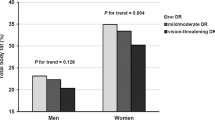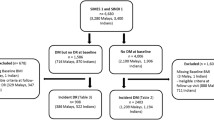Abstract
Aims
To explore the factors mediating the relationship between body mass index (BMI) and diabetic retinopathy (DR) in Chinese type 2 diabetes patients.
Methods
This is a cross-sectional study. Data of 2,533 patients with type 2 diabetes were studied from the Shanghai Diabetes Registry Database. DR was assessed using non-mydriatic fundus photography and graded as non-DR, mild–moderate (DR I–II), and sight-threatening (DR III–IV). BMI (kg/m2) was classified as normal weight (18.5 ≤ BMI < 25), overweight (25 ≤ BMI < 30), and obese (BMI ≥ 30). β cell function was evaluated by fasting C-peptide (FCP).
Results
DR was present in 701 (27.7 %) patients. Patients with DR had lower BMI (24.3 vs. 24.9 kg/m2, P = 0.001) and fasting C-peptide (1.46 vs. 1.86 ng/ml, P < 0.001) than those without DR. The association between BMI (2 kg/m2 interval) and DR was U-shaped; patients with BMI 28–29.9 kg/m2 had the lowest DR rate. Compared with normal weight, overweight was associated with reduced risk of any DR [odds ratio (OR) 0.73], DR I–II (OR 0.76), and DR III–IV (OR 0.64) after adjustment for sex, age at diabetes diagnosis, and duration of diabetes. This negative association attenuated after adjustment for other confounders and became nonsignificant after further adjustment for FCP. Patients with different BMI categories had similar DR risk when stratified by FCP tertiles.
Conclusion
Overweight patients have lower DR prevalence than normal weight individuals, which may be attributable to better β cell function in overweight patients.


Similar content being viewed by others
References
Garvey WT, Garber AJ, Mechanick JI et al (2014) American association of clinical endocrinologists and american college of endocrinology position statement on the 2014 advanced framework for a new diagnosis of obesity as a chronic disease. Endocr Pract 20:977–989
Hou X, Lu J, Weng J et al (2013) Impact of waist circumference and body mass index on risk of cardiometabolic disorder and cardiovascular disease in Chinese adults: a national diabetes and metabolic disorders survey. PLoS ONE 8:e57319
Khalangot M, Tronko M, Kravchenko V, Kulchinska J, Hu G (2009) Body mass index and the risk of total and cardiovascular mortality among patients with type 2 diabetes: a large prospective study in Ukraine. Heart 95:454–460
Eeg-Olofsson K, Cederholm J, Nilsson PM et al (2009) Risk of cardiovascular disease and mortality in overweight and obese patients with type 2 diabetes: an observational study in 13,087 patients. Diabetologia 52:65–73
Maric C, Hall JE (2011) Obesity, metabolic syndrome and diabetic nephropathy. Contrib Nephrol 170:28–35
Logue J, Walker JJ, Leese G et al (2013) Association between BMI measured within a year after diagnosis of type 2 diabetes and mortality. Diabetes Care 36:887–893
Gruberg L, Weissman NJ, Waksman R et al (2002) The impact of obesity on the short-term and long-term outcomes after percutaneous coronary intervention: the obesity paradox? J Am Coll Cardiol 39:578–584
Karlberg C, Falk C, Green A, Sjolie AK, Grauslund J (2012) Proliferative retinopathy predicts nephropathy: a 25-year follow-up study of type 1 diabetic patients. Acta Diabetol 49:263–268
Pradeepa R, Surendar J, Indulekha K, Chella S, Anjana RM, Mohan V (2014) Relationship of diabetic retinopathy with coronary artery disease in Asian Indians with type 2 diabetes: The Chennai Urban Rural Epidemiology Study (CURES) Eye Study-3. Diabetes Technol Ther [Epub ahead of print]
Miyamoto M, Kotani K, Okada K et al (2012) The correlation of common carotid arterial diameter with atherosclerosis and diabetic retinopathy in patients with type 2 diabetes mellitus. Acta Diabetol 49:63–68
Yau JW, Rogers SL, Kawasaki R et al (2012) Global prevalence and major risk factors of diabetic retinopathy. Diabetes Care 35:556–564
Trento M, Passera P, Trevisan M et al (2013) Quality of life, impaired vision and social role in people with diabetes: a multicenter observational study. Acta Diabetol 50:873–877
Ding J, Wong TY (2012) Current epidemiology of diabetic retinopathy and diabetic macular edema. Curr Diabetes Rep 12:346–354
Brown JB, Pedula KL, Summers KH (2003) Diabetic retinopathy: contemporary prevalence in a well-controlled population. Diabetes Care 26:2637–2642
Diabetes Prevention Program Research Group (2007) The prevalence of retinopathy in impaired glucose tolerance and recent-onset diabetes in the diabetes prevention program. Diabet Med 24:137–144
Writing Team for the Diabetes C, Complications Trial, Epidemiology of Diabetes I, Complications Research G (2002) Effect of intensive therapy on the microvascular complications of type 1 diabetes mellitus. JAMA 287:2563–2569
Keen H, Lee ET, Russell D, Miki E, Bennett PH, Lu M (2001) The appearance of retinopathy and progression to proliferative retinopathy: the WHO multinational study of vascular disease in diabetes. Diabetologia 44(Suppl 2):S22–S30
van Leiden HA, Dekker JM, Moll AC et al (2002) Blood pressure, lipids, and obesity are associated with retinopathy: the hoorn study. Diabetes Care 25:1320–1325
Cai X, Han X, Zhang S, Luo Y, Chen Y, Ji L (2014) Age at diagnosis and C-peptide level are associated with diabetic retinopathy in Chinese. PLoS ONE 9:e91174
Azad N, Agrawal L, Emanuele NV, Klein R, Bahn GD, Reaven P (2014) Association of blood glucose control and pancreatic reserve with diabetic retinopathy in the veterans affairs diabetes trial (VADT). Diabetologia 57:1124–1131
Tolonen N, Hietala K, Forsblom C et al (2013) Associations and interactions between lipid profiles, retinopathy and nephropathy in patients with type 1 diabetes: the FinnDiane Study. J Intern Med 274:469–479
Henricsson M, Nystrom L, Blohme G et al (2003) The incidence of retinopathy 10 years after diagnosis in young adult people with diabetes: results from the nationwide population-based diabetes incidence study in Sweden (DISS). Diabetes Care 26:349–354
Zhang L, Krzentowski G, Albert A, Lefebvre PJ (2001) Risk of developing retinopathy in diabetes control and complications trial type 1 diabetic patients with good or poor metabolic control. Diabetes Care 24:1275–1279
Dirani M, Xie J, Fenwick E et al (2011) Are obesity and anthropometry risk factors for diabetic retinopathy? The diabetes management project. Invest Ophthalmol Vis Sci 52:4416–4421
van Leiden HA, Dekker JM, Moll AC et al (2003) Risk factors for incident retinopathy in a diabetic and nondiabetic population: the Hoorn study. Arch Ophthalmol 121:245–251
Rooney D, Lye WK, Tan G, et al (2014) Body mass index and retinopathy in Asian populations with diabetes mellitus. Acta Diabetol. doi:10.1007/s00592-014-0602-2
Raman R, Rani PK, Gnanamoorthy P, Sudhir RR, Kumaramanikavel G, Sharma T (2010) Association of obesity with diabetic retinopathy: Sankara Nethralaya diabetic retinopathy epidemiology and molecular genetics study (SN-DREAMS Report no. 8). Acta Diabetol 47:209–215
Looker HC, Nyangoma SO, Cromie D et al (2012) Diabetic retinopathy at diagnosis of type 2 diabetes in Scotland. Diabetologia 55:2335–2342
Gu Y, Wang C, Zheng Y et al (2013) Cancer incidence and mortality in patients with type 2 diabetes treated with human insulin: a cohort study in Shanghai. PLoS ONE 8:e53411
Chinese Diabetes Society (2012) Guidelines for the prevention and treatment of type 2 diabetes in China (2010). Chin J Diabetes 20:81–117
(2000) Obesity: preventing and managing the global epidemic. Report of a WHO consultation. World Health Organ Tech Rep Ser 894:i–xii, 1–253
Wilkinson CP, Ferris FL 3rd, Klein RE et al (2003) Proposed international clinical diabetic retinopathy and diabetic macular edema disease severity scales. Ophthalmology 110:1677–1682
de Mutsert R, Sun Q, Willett WC, Hu FB, van Dam RM (2014) Overweight in early adulthood, adult weight change, and risk of type 2 diabetes, cardiovascular diseases, and certain cancers in men: a cohort study. Am J Epidemiol 179:1353–1365
Hou X, Jia W, Bao Y et al (2008) Risk factors for overweight and obesity, and changes in body mass index of Chinese adults in Shanghai. BMC Public Health 8:389
Rahier J, Guiot Y, Goebbels RM, Sempoux C, Henquin JC (2008) Pancreatic beta-cell mass in European subjects with type 2 diabetes. Diabetes Obes Metab 10(Suppl 4):32–42
Ahren J, Ahren B, Wierup N (2010) Increased beta-cell volume in mice fed a high-fat diet: a dynamic study over 12 months. Islets 2:353–356
Lachin JM, McGee P, Palmer JP (2014) Impact of C-peptide preservation on metabolic and clinical outcomes in the diabetes control and complications trial. Diabetes 63:739–748
Steffes MW, Sibley S, Jackson M, Thomas W (2003) Beta-cell function and the development of diabetes-related complications in the diabetes control and complications trial. Diabetes Care 26:832–836
Panero F, Novelli G, Zucco C et al (2009) Fasting plasma C-peptide and micro- and macrovascular complications in a large clinic-based cohort of type 1 diabetic patients. Diabetes Care 32:301–305
Suzuki K, Watanabe K, Motegi T, Kajinuma H (1989) High prevalence of proliferative retinopathy in diabetic patients with low pancreatic B-cell capacity. Diabetes Res Clin Pract 6:45–52
Boz M, Scheen AJ, Gerard PL, Castillo MJ, Lefebvre PJ (1995) Retinopathy, but not neuropathy, is influenced by the level of residual endogenous insulin secretion in type 2 diabetes. Diabete Metab 21:353–359
Bo S, Cavallo-Perin P, Gentile L, Repetti E, Pagano G (2000) Relationship of residual beta-cell function, metabolic control and chronic complications in type 2 diabetes mellitus. Acta Diabetol 37:125–129
Genuth SM (1996) Clinical utility of C-peptide measurement in diabetes mellitus. Endocr Pract 2:266–268
Jones AG, Hattersley AT (2013) The clinical utility of C-peptide measurement in the care of patients with diabetes. Diabet Med 30:803–817
Marques RG, Fontaine MJ, Rogers J (2004) C-peptide: much more than a byproduct of insulin biosynthesis. Pancreas 29:231–238
Conflict of interest
The authors declare that they have no conflict of interest.
Ethical standard
This study was approved by the Institutional Ethics Committee of Shanghai Jiao Tong University Affiliated Sixth People’s Hospital, China.
Human and Animal Rights disclosure
All procedures followed were in accordance with the ethical standards of the responsible committee on human experimentation (institutional and national) and with the Helsinki Declaration of 1975, as revised in 2008 (5).
Informed consent disclosure
Informed consent was obtained from all patients for being included in the study.
Author information
Authors and Affiliations
Corresponding author
Additional information
Managed by Antonio Secchi.
Jun Lu and Xuhong Hou have contributed equally to this article.
Electronic supplementary material
Below is the link to the electronic supplementary material.
Rights and permissions
About this article
Cite this article
Lu, J., Hou, X., Zhang, L. et al. Association between body mass index and diabetic retinopathy in Chinese patients with type 2 diabetes. Acta Diabetol 52, 701–708 (2015). https://doi.org/10.1007/s00592-014-0711-y
Received:
Accepted:
Published:
Issue Date:
DOI: https://doi.org/10.1007/s00592-014-0711-y




